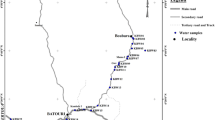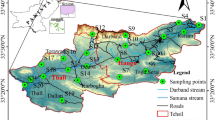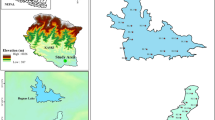Abstract
The present investigation was conducted in order to evaluate the occurrence and distribution patterns of some potentially harmful trace elements in the borehole water of the Greater Giyani area, Limpopo, South Africa, and their possible implications on human health. Twenty-nine borehole water samples were collected in the dry season (July/August 2012) and another 27 samples from the same localities in the wet season (March 2013) from the study area. The samples were analysed for trace elements arsenic (As), cadmium (Cd), chromium (Cr), selenium (Se), and lead (Pb) using the inductively coupled plasma mass spectrometry technique. The average concentrations of As, Cd, Cr, Se, and Pb were 11.3, 0.3, 33.1, 7.1, and 6.0 µg/L in the dry season and 11.0, 0.3, 28.3, 4.2, and 6.6 µg/L in the wet season, respectively. There was evidence of seasonal fluctuations in concentrations of all analysed elements except for As, though Cd and Pb displayed low concentrations (<0.2 and <6.0 µg/L, respectively) in almost all sampled boreholes. Se and Cr concentrations slightly exceed the South African National Standard permissible limits for safe drinking water in few boreholes. A total of four boreholes exceeded the water quality guideline for As with two of these boreholes containing five times more As than the prescribed limit. The spatial distribution patterns of elevated As closely correlate with the underlying geology. The findings of this investigation have important implications for human health of the communities drinking from the affected boreholes.

(Modified from: Council for Geoscience GIS database)

(Modified from: Council for Geoscience GIS database)










Similar content being viewed by others
References
Afridi, H. I., Kazi, T. G., Kazi, G. H., Jamali, M. K., & Shar, G. Q. (2006). Essential trace and toxic elements distribution in the scalp hair of Pakistani Myocardial Infarction patients and controls. Biological Trace Elements Research, 113, 19–33.
Agbalagba, O. E., Agbalagba, O. H., Ononugbo, C. P., & Alo, A. A. (2011). Investigation into the physic-chemical properties and hydrochemical processes of groundwater from commercial boreholes in Yenagoa, Bayelsa State, Nigeria. African Journal of Environmental Science and Technology, 5(7), 473–481.
Anhaeusser, C. R. (1992). Structures in granitoid gneisses and associated migmatites close to the granulite boundary of the Limpopo Belt, South Africa. Precambrian Research, 55, 81–92.
Ayotte, J. D., Belaval, M., Alson, S. A., Burow, K. R., Flanagan, S. M., Hinkle, S. R. H., et al. (2015). Factors affecting temporal variability of arsenic in groundwater used from drinking water supply in the United States. Science of Total Environment,. doi:10.1016/j.scitotenv.2014.02.057.
Ayotte, D., Montgomery, D. L., Flanagan, S. M., & Robison, K. W. (2003). Arsenic in groundwater in eastern New England: Occurrence, control, and human health implications. Environmental Science and Technology, 15(10), 83–20157.
Baglow, N. (2005). A geological description of sheets 2329CD Pietersburg and 2329DC Mankweng. Explanation of 1:50,000 scale Sheet 2329CD Pietersburg and 2329DC Mankweng.
Bailey, R. T., Cody, B. C., & Gates, T. K. (2009). Mobilization and reactive transport of selenium in a stream-aquifer system: From field monitoring towards remediation modelling. Hydrology days. Department of Civil and Environmental Engineering. Colorado State University. http://hydrologydays.colostate.edu/Papers_2009/Bailey_paper.pdf. Accessed January 8, 2013.
Bassil, J., Naveau, A., Bodin, J., Fontaine, C., Di Tullo, P., Razarc, M., et al. (2014). The nature of selenium species in the hydrological experimental site of Poitiers. Procedia Earth and Planetary Science, 10, 159–163.
Belyanin, G. A., Kramers, J. D., Vorster, C., & Knoper, M. W. (2014). The timing of successive fluid events in the Southern Marginal Zone of the Limpopo Complex, South Africa: Constraints from 40Ar–39Ar geochronology. Precambrian Research, 254, 169–193.
Bernard, A. (2008). Cadmium and its adverse effects on human health. The Indian Journal of Medical Research, 128(4), 64–557.
Bodenan, F., Baranger, P., Piantone, P., Lassin, A., Azaroual, M., Gaucher, E., et al. (2004). Arsenic behaviour in gold-ore mill tailings, Massif Central, France: Hydrogeochemical study and investigation of in situ redox signatures. Applied Geochemistry, 19, 1785–1800.
Brandl, G. (1986). The geology of the Pietersburg area. Explanation of 1: 250,000 scale Sheet 2328 Pietersburg. Geological Survey South Africa (pp. 4–6 & 13–15).
Brandl, G. (1987). The geology of the Tzaneen area. Explanation of 1:250,000 scale Sheet of 2330 Tzaneen. Geological Survey South Africa (pp. 3–5, 15–19, 25–25, 30–31).
Brandl, G., & Kröner, A. (1993). Preliminary results of single zircon studies from various Archaean rocks of north-eastern Transvaal. Abstract. 16th Coll. African Geology, Mbabane, Swaziland (Vol. 1, pp. 54–56).
Celik, I. L., Gallicchio, L., Boyd, K., Lam, T. K., Matanoski, G., Tao, X., et al. (2008). Arsenic in drinking water and lung cancer: A systematic review. Environmental Research,. doi:10.1016/j.envres.
Chen, J. (2012). An original discovery: Selenium deficiency and Keshan disease (an endemic heart disease). Asian Pacific Journal of Clinical Nutrition, 21(3), 6–320.
Department of Water Affairs (DWAF). (n.d.). Limpopo groundwater resource information project (GRIP). http://www.dwaf.gov.za/Groundwater/GroundwaterOffices/Limpopo/GRIP_Limpopo.pdf. Accessed November 2, 2012.
Department of Water Affairs and forestry (DWAF). (2000). Policy and strategy for Groundwater quality management in South Africa. Pretoria, Republic of South Africa. https://www.westerncape.gov.za/text/2003/groundwaterpol.pdf. Accessed November 15, 2010.
Department of Water Affairs and forestry (DWAF). (2004). South Africa’s water situation and strategies to balance supply and demand. National Water Resource Strategy, http://www.dwaf.gov.za/nwrs/LinkClick.aspx?fileticket=15NoZWfpDjY%3D&tabid=63&mid=412. Accessed November 15, 2010.
Department of Water Affairs and forestry (DWAF). (2006). Letaba catchment reserve determination study-groundwater report final. Republic of South Africa. https://www.dwa.gov.za/rdm/documents/Briefing%20Document.pdf. Accessed May 19, 2014.
Duker, A. A., Carranza., E .J. M. & Hale, M. (2005). Arsenic geochemistry and health. Environmental International, 31, 631–641. http://www.dwaf.gov.za/Groundwater/GroundwaterOffices/Limpopo/GRIP_Limpopo.pdf. Accessed November 2, 2012.
Du Toit, W. H., & Van Lelyveld, M. (2010). An explanation of the 1: 500 000 general hydrological Map. Phalaborwa 2330. Unpublished report.
Dzombak, M. J., & Morel, F. M. M. (1990). Surface complexation modelling-hydrous ferric oxide. New York: Wiley.
Edmunds, W. M., & Smedley, P. L. (1996). Groundwater geochemistry and health: An overview. In J. D. Fuge & G. J. H. McCall (Eds.), Environmental geochemistry and health (pp. 91–105). London: Geological Society Special Publication.
Fawell, J., & Nieuwenhuijsen, M. J. (2003). Contaminants in drinking water. British Medical Bulletin, 68, 199–208.
Ferreccio, C., Gonzalez, C., Milosavjlevic, V., Marshall, G., & Smith, A. H. (2000). Lung cancer and arsenic concentrations in drinking water in Chile. Epidemiology, 11(6), 9–673.
Ferreccio, C., & Sancha, A. M. (2006). Arsenic exposure and its impacts on health in Chile. International Centre for Diarrhoeal Disease Research, 24(2), 164–175.
Finkelstein, Y., Markowitz, M. E., & Rosen, J. F. (1998). Low-level lead induced neurotoxicity in children: An update on central nervous system effects. Brain Research Review, 27, 168–179.
Gan, S., & Van Reenen, D. D. (1996). Geology of gold deposits in the Southern Marginal Zone of the Limpopo belt and adjacent Sutherland greenstone belt, South Africa: Klein Letaba. South African Journal of Geology, 100, 73–83.
Haupt, C. J., & Sami, K. (2006). Letaba catchment reserve determination study-groundwater. Final report. Department of water affairs and forestry. South Africa. http://www.dwaf.gov.za/nwrs/LinkClick.aspx?fileticket=15NoZWfpDjY%3D&tabid=63&mid=412. Accessed November 15, 2010.
Hewit, A. D. (1989). Leaching of metal pollutants from four well casing used for groundwater monitoring U.S. Army Corps of Engineers Coid Region Research and Engineering. Laboratory Special Report, 89-32, 1.
Hopenhayn-Rich, C., Biggs, M., & Smith, A. H. (1998). Lung and kidney cancer mortality associated with arsenic in drinking water in Cordoba Argentina. International Epidemiological Association, 27, 561–569. http://asrg.berkeley.edu/index_files/Publications_PDF/98HopenhaynLungKidneyCancer.pdf. Accessed August 21, 2014.
Hudak, P. F. (2010). Nitrate, arsenic and selenium concentrations in the Pecos valley aquifer, West Texas, USA. International Journal of Environmental Research, 4(2), 229–236.
Hutton, M. (1987). Human health concerns of lead, mercury, cadmium and arsenic. In T. C. Hutchnson & K. M. Meema (Eds.), Lead, mercury, cadmium and arsenic in the environment (pp. 53–68). New York: Wiley.
Huvinen, M., Uitti, J., Oksa, P., Palmroos, P., & Laippala, P. (2002). Respiratory health effects of long-term exposure to different chromium species in stainless steel production. Occupational Medicine, 52(4), 204–212. http://occmed.oxfordjournals.org/content/52/4/203.full.pdf+html Accessed August 21, 2014.
International Agency for Research on Cancer (IARC). (2012). A review of human carcinogens: Arsenic, metals, fibres, and dusts. Lyon: World Health Organization Press. http://monographs.iarc.fr/ENG/Monographs/vol100C/. Accessed January 20, 2016.
International Agency for Research on Cancer (IARC). (2016). IARC monograph on the evaluation of carcinogenic risks to humans. World health Organization. http://monographs.iarc.fr/ENG/Classification/. Accessed February 22, 2016.
Kapaj, S., Peterson, H., Liber, K., & Bhattacharya, P. (2006). Human health effects from chronic arsenic poisoning—A review. Journal of Environmental Science and Health part A, 41, 2399–2428. http://monographs.iarc.fr/ENG/Classification/. Accessed February 22, 2016.
Katz, B. G., Berndt, M. P., Bullen, T. D. & Hansard, P. (1999). Factors controlling elevated lead concentrations in water samples from aquifer system in Florida. Water Resources Investigations Report 99-4020. United State Geological Survey, Florida. http://fl.water.usgs.gov/PDF_files/wri99_4020_katz.pdf. Accessed August 21, 2014.
Kramers, J. D., Henzen, M., & Steidle, L. (2014). Greenstone belts at the northernmost edge of the Kaapvaal Craton: Timing of tectonic events and a possible crustal fluid source. Precambrian Research, 253, 96–113.
Kreissig, K., Holzer, L., Frei, R., Villa, I. M., Kramers, J. D., Kröner, A., et al. (2001). Geochronology of the Hout River Shear Zone and the metamorphism in the Southern Marginal Zone of the Limpopo Belt, Southern Africa. Precambrian Research, 109, 145–173.
Kroner, A., Jaeckel, P., & Brandl, G. (2000). Single zircon ages for felsic to intermediate rocks from the Pietersburg and Giyani greenstone belts and bordering granitoid orthogneisses, northern Kaapvaal Craton, South Africa. Journal of African Earth Science, 30(4), 773–793.
Langard, S. (1990). One hundred years of chromium and cancer: A review of epidemiological evidence and selected case reports. American Journal of Industrial Medicine, 17(2), 189–215.
Lenz, M., & Lens, P. N. L. (2009). The essential toxin: The changing Perception of selenium in environmental science. The Science of the Total Environment,. doi:10.1016/j.scitotenv.2008.07.056.
Linos, A., Petralias, A., Christophi, C. A., Christoforidou, E., Kouroutou, P., Stoltidis, M., et al. (2011). Oral ingestion of hexavalent chromium through drinking water and cancer mortality in an industrial area of Greece—An ecological study. Environmental Health, 10, 50.
Massecheleyn, P. H., Delaune, R. D., & Patrick, W. H. (1991). Effect of redox potential and pH. On arsenic speciation and solubility in a contaminated soil. Environmental Science and Technology, 25, 1414–1419.
Mazumder, D. N. G. (2008). Chronic arsenic toxicity and health. Indian Journal of Medicine, 28, 436–447.
McCarty, K. M., Hanh, H. T., & Kim, K. W. (2011). Arsenic geochemistry and human health in South East Asia. Reviews Environmental Health, 26(1), 71–78.
Mehra, R., & Juneja, M. (2003). Adverse health effects in workers exposed to trace/toxic metals at work place. Indian Journal of Biochemistry & Biophysics, 40, 133–135.
Meyer, J. A., & Casey, N. H. (2004). Exposure assessment of potentially toxic trace elements in indigenous goats in the rural communal production systems of the northern region of South Africa. South African Journal of Animal Science, 34, 219–222.
Mopani District Municipality. (2008). Reviewed integrated development plan 2006/2011. Republic of South Africa. http://www.kruger2canyons.org/037%20-%20Mopani%20IDP%202008.pdf. Accessed April 6, 2014.
Motzer, W. & Engineers, T. (2004). Chemistry, geochemistry and geology of chromium and chromium compounds. In J. Guertin, J. A. Jacobs & C. P. Avakian (Eds.), Chromium (VI) handbook. Library of Congress Cataloguing-in Publication Data (pp. 23–761). United States of America.
Nath, A., Vendan, P. S. E., Kumar, S., Kumar, A., & Singh, J. K. (2013). Toxicity due to arsenic in Gangetic Zone of Patna, India and its linkage to cancer. Journal of Environmental and Analytical Toxicology, 3, 6.
Oze, C., Bird, D. K., & Fendorf, S. (2007). Genesis of hexavalent chromium from natural sources in soil and groundwater. In PNAS. Proceedings of the National Academy of Sciences, 104 (16), 6544–6549. http://www.pnas.org/content/104/16/6544.full.pdf+html. Accessed July 13, 2013.
Putila, J. J., & Guo, N. L. (2011). Association of arsenic exposure with lung cancer incidence rates in the United States. http://www.plosone.org/article/fetchObject.action?uri=info:doi/10.1371/journal.pone.0025886&representation=PDF. Accessed May 13, 2015.
Robb, L. J., Brandl, G., Anhaeusser, C. R., & Poujol, M. (2006). Archaean granitoid intrusions. In M. R. Johnson, C. R. Anhaeusser & R. J. Thomas (Eds.), The geology of South Africa (pp. 0–73). Pretoria: Geological Society of South Africa, Council for Geoscience.
Sami, K., & Druzynski, A. L. (2003). Predicted spatial distribution of naturally occurring arsenic, selenium and uranium in groundwater in South Africa Reconnaissance survey. Water Research Commission. Report No 1236/1/03, Pretoria, South Africa. http://www.wrc.org.za/Knowledge%20Hub%20Documents/Research%20Reports/1236-1-03.pdf. Accessed January 21, 2014.
Smedley, P. L., & Kinniburgh, D. G. (2002). A review of the source, behaviour and distribution of arsenic material in natural waters. Applied Geochemistry, 17, 517–568.
Smedley, P. L., Knudsen, J., & Maiga, D. (2007). Arsenic in groundwater from mineralized Proterozoic basement rocks of Burkina Faso. Applied Geochemistry, 22, 1074–1092.
Smith, A. H., Hopenhayn-Rich, C., Bates, M. N., Geoden, H. M., Hertz-Picciotto, I., Duggan, H. M., et al. (1992). Cancer risks from arsenic in drinking water. Environmental Health Perspectives, 97, 259–267.
Smith, A. H., Lingas, E. O., & Rahman, M. (2000). Contamination of drinking water by arsenic in Bangladesh: A public health emergency. Bulletin of the Word Heal Organization, 78(9). http://www.who.int/bulletin/archives/78(9)1093.pdf. Accessed February 16, 2016.
Sohel, N., Persson, L. A., Rahman, M., Streatfield, P. K., Yunus, M., & Vahter, M. (2009). Arsenic in drinking water and adult mortality: A population based-cohort study in rural Bangladesh. Epidemiology,. doi:10.1097/EDE.0b013e3181bb56ec.
South African National Standard (SANS). (2011). South African National Standard of Drinking water Part 1: Microbiological, physical, aesthetic and chemical determinands. Pretoria: SABS Standard Division.
Steinmaus, C. M., Yuan, Y., & Smith, A. H. (2005). The temporal stability of arsenic concentrations in wells in water in western Nevada. Abstract, Pubmed. http://www.ncbi.nlm.nih.gov/pubmed/16194666. Accessed February 16, 2016.
Thundiyil, J. G., Yuan, Y., Smith, A. H., & Steinmaus, C. (2007). Seasonal variations of arsenic in wells in Nevada. Environmental Research,. doi:10.1016/j.envres.2007.02.007.
Umemura, T., & Wako, Y. (2006). Pathogenesis of osteomalacia in itai–itai disease. Journal of Pathology, 19, 69–74.
United Nations Environmental Programme (UNEP). (2010). Final review of scientific information on cadmium. http://www.unep.org/hazardoussubstances/Portals/9/Lead_Cadmium/docs/Interim_reviews/UNEP_GC26_INF_11_Add_2_Final_UNEP_Cadmium_review_and_apppendix_Dec_2010.pdf. Accessed July 10, 2013.
Water Research Commission (WRC). (2009). Tracking trace constituents in groundwater. Technical brief 1–2. http://www.wrc.org.za/Knowledge%20Hub%20Documents/Briefs/TB%20trace%20constituents%20in%20groundwater.pdf. Accessed September 30, 2010.
Weaver, J. M. C., Cave, L. & Talma, A. S. (2007). Groundwater sampling: A comprehensive guide for sampling methods (2nd ed.). Water Research Commission, Report no TT 303/07. Republic of South Africa.
Welch, A. H., Westjohn, B. B., Helsel, D. R., & Wanty, R. B. (2000). Arsenic in groundwater of the United States: Occurrence and geochemistry. Groundwater, 38(4), 589–604.
World Health Organisation (WHO). (2010). Childhood lead poisoning. http://www.who.int/ceh/publications/leadguidance.pdf. Accessed May 16, 2016.
World Health Organisation (WHO). (2011). Selenium in drinking water. Background document for development of WHO guidelines for drinking water quality. World Health Organization. Geneva. Switzerland. http://www.who.int/water_sanitation_health/dwq/chemicals/selenium.pdf. Accessed July 10, 2013.
Wright, W. G. (1999). Oxidation and mobilization of selenium by nitrate in irrigation drainage. Journal of Environmental Quality, 28(4), 1182–1187. http://www.swhydrologic.com/reports/wright_jeq_se-no3.pdf. Accessed July 18, 2013.
Acknowledgments
The authors are grateful to the Council for Geoscience and the National Research Foundation (Incentive Funding for Rated Researchers to HM, Grant No. 91059) for providing financial support for this investigation and the anonymous reviewers and the Editor for their valuable comments and suggestions, which helped to improve the quality of the manuscript.
Author information
Authors and Affiliations
Corresponding author
Rights and permissions
About this article
Cite this article
Munyangane, P., Mouri, H. & Kramers, J. Assessment of some potential harmful trace elements (PHTEs) in the borehole water of Greater Giyani, Limpopo Province, South Africa: possible implications for human health. Environ Geochem Health 39, 1201–1219 (2017). https://doi.org/10.1007/s10653-016-9887-0
Received:
Accepted:
Published:
Issue Date:
DOI: https://doi.org/10.1007/s10653-016-9887-0




